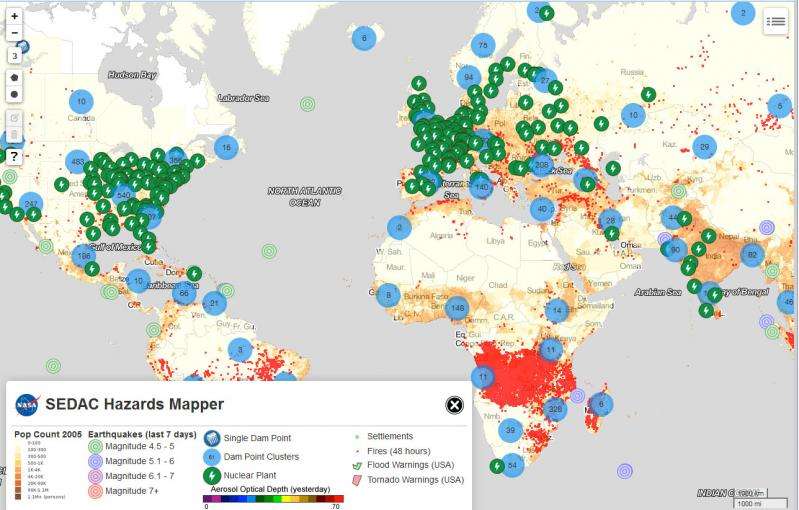New mapping tool lets users easily pinpoint hazards data

A new online mapping tool, the SEDAC Hazards Mapper, enables users to easily display recent natural hazards data in relationship to population, human settlements, major infrastructure, and satellite imagery, and to analyze potential impacts and exposure.
Hazards data include the location of active fires over the past 48 hours; earthquake alerts over the past seven days; flood and tornado warnings in the U.S. in near real-time; and yesterday′s air pollution data measured from space.
The mapper shows the location of major dams and nuclear power plants and provides more detailed information and imagery for these facilities where available. By drawing a circle or polygon around a point or area of interest on the map, users can obtain an estimate of the total population and land area enclosed within.
Developed by the NASA Socioeconomic Data and Applications Center operated by the Center for International Earth Science Information Network (CIESIN), the SEDAC Hazards Mapper combines layers from various sources including the NASA Land, Atmosphere Near real-time Capability for EOS (LANCE) and Global Imagery Browse Services (GIBS), the U.S. Geological Survey (USGS), the National Oceanic and Atmospheric Administration (NOAA), Esri, and others, using a variety of open Web mapping services.
The population and settlement data are based on SEDAC′s Gridded Population of the World, version 3 (GPWv3) data for 2005 and the Global Rural Urban Mapping Project (GRUMP) data collection. The custom population estimates are provided by the SEDAC Population Estimation Service (PES). SEDAC plans to add more hazard and infrastructure layers and update the population data in early 2016.
The mapper is designed to be used by disaster risk managers, humanitarian response organizations, public health professionals, journalists, and others needing a quick assessment of the potential dangers posed by a major hazardous event or developing emergency. For example, a disaster response agency can obtain a rough estimate of the population and major facilities near a recent earthquake or a predicted flood as an input into response planning. Journalists or students can explore the location of recent wildfires relative to human settlements, dense populations, roads, terrain, and water bodies. Due to the coarse resolution and varying quality of some of the data, the mapper is not intended to support in-depth risk assessment or location-specific response needs.
Provided by Earth Institute, Columbia University




















